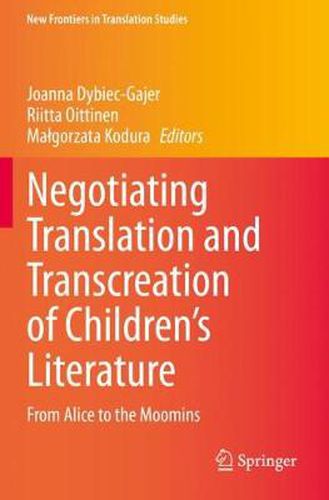Readings Newsletter
Become a Readings Member to make your shopping experience even easier.
Sign in or sign up for free!
You’re not far away from qualifying for FREE standard shipping within Australia
You’ve qualified for FREE standard shipping within Australia
The cart is loading…






This title is printed to order. This book may have been self-published. If so, we cannot guarantee the quality of the content. In the main most books will have gone through the editing process however some may not. We therefore suggest that you be aware of this before ordering this book. If in doubt check either the author or publisher’s details as we are unable to accept any returns unless they are faulty. Please contact us if you have any questions.
This book offers fresh critical insights to the field of children’s literature translation studies by applying the concept of transcreation, established in the creative industries of the globalized world, to bring to the fore the transformative, transgressional and creative aspects of rewriting for children and young audiences. This socially situated and culturally dependent practice involves ongoing complex negotiations between creativity and normativity, balancing text-related problems and genre conventions with readers’ expectations, constraints imposed by established, canonical translations and publishers’ demands. Focussing on the translator’s strategies and decision-making process, the book investigates phenomena where transcreation is especially at play in children’s literature, such as dual address, ambiguity, nonsense, humour, play on words and other creative language use; these also involve genre-specific requirements, for example, rhyme and rhythm in poetry. The book draws on a wide range of mostly Anglophone texts for children and their translations into languages of limited diffusion to demonstrate the numerous ways in which information, meaning and emotions are transferred to new linguistic and cultural contexts. While focussing mostly on interlingual transfer, the volume analyses a variety of translation types from established, canonical renditions by celebrity translators to non-professional translations and intralingual rewritings. It also examines iconotextual dynamics of text and image. The book employs a number of innovative methodologies, from cognitive linguistics and ethnolinguistics to semiotics and autoethnographic approaches, going beyond text analysis to include empirical research on children’s reactions to translation strategies. Highlighting the complex dynamics at work in the process of transcreating for children, this volume is essential reading for students and researchers in translation studies, children’s fiction and adaptation studies.
$9.00 standard shipping within Australia
FREE standard shipping within Australia for orders over $100.00
Express & International shipping calculated at checkout
This title is printed to order. This book may have been self-published. If so, we cannot guarantee the quality of the content. In the main most books will have gone through the editing process however some may not. We therefore suggest that you be aware of this before ordering this book. If in doubt check either the author or publisher’s details as we are unable to accept any returns unless they are faulty. Please contact us if you have any questions.
This book offers fresh critical insights to the field of children’s literature translation studies by applying the concept of transcreation, established in the creative industries of the globalized world, to bring to the fore the transformative, transgressional and creative aspects of rewriting for children and young audiences. This socially situated and culturally dependent practice involves ongoing complex negotiations between creativity and normativity, balancing text-related problems and genre conventions with readers’ expectations, constraints imposed by established, canonical translations and publishers’ demands. Focussing on the translator’s strategies and decision-making process, the book investigates phenomena where transcreation is especially at play in children’s literature, such as dual address, ambiguity, nonsense, humour, play on words and other creative language use; these also involve genre-specific requirements, for example, rhyme and rhythm in poetry. The book draws on a wide range of mostly Anglophone texts for children and their translations into languages of limited diffusion to demonstrate the numerous ways in which information, meaning and emotions are transferred to new linguistic and cultural contexts. While focussing mostly on interlingual transfer, the volume analyses a variety of translation types from established, canonical renditions by celebrity translators to non-professional translations and intralingual rewritings. It also examines iconotextual dynamics of text and image. The book employs a number of innovative methodologies, from cognitive linguistics and ethnolinguistics to semiotics and autoethnographic approaches, going beyond text analysis to include empirical research on children’s reactions to translation strategies. Highlighting the complex dynamics at work in the process of transcreating for children, this volume is essential reading for students and researchers in translation studies, children’s fiction and adaptation studies.